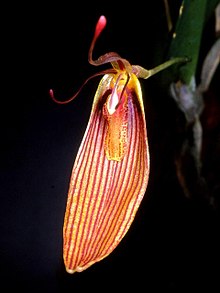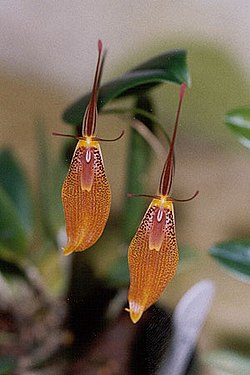| Restrepia | |
|---|---|

| |
| Antennae-carrying Restrepia (Restrepia antennifera) | |
| Scientific classification | |
| Kingdom: | Plantae |
| Clade: | Tracheophytes |
| Clade: | Angiosperms |
| Clade: | Monocots |
| Order: | Asparagales |
| Family: | Orchidaceae |
| Subfamily: | Epidendroideae |
| Tribe: | Epidendreae |
| Subtribe: | Pleurothallidinae |
| Genus: | Restrepia Kunth (1816) |
| Type species | |
| Restrepia antennifera Kunth in F.W.H.von Humboldt, A.J.A.Bonpland & C.S.Kunth | |
Restrepia, abbreviated Rstp in horticultural trade, is a small genus of 50 species in the orchid family (Orchidaceae), closely related to Pleurothallis. Named in honor of Don Jose Restrepo, it tends to be more showy than most other Pleurothallids. They are found primarily at higher altitudes in the cool, damp montane forests of the Andes and Venezuela, with some into Central America up to southern Mexico.
Description

These tiny epiphytic and rarely lithophytic orchids lack pseudobulbs. The erect, thick, leathery leaf is elliptic-ovate in shape. The aerial roots seem like fine hairs.
The flowers develop one at a time at the base of the leaf. They are borne on a slender peduncle, originating from the base of the back of the leaf. The long dorsal sepal is erect and ends in a somewhat thicker club-shaped tip. They have fused lateral sepals (synsepals) which may be quite colorful : white, yellow, rose, purple, orange or tan with red, brown or purple overlaid frequently with contrasting reddish-purple spots or stripes. The long, lateral petals equally end in a thickened club-shaped tip. The long lip is ovoid and widest its apex. It shows the same variations in color and markings.
They are generally of tufted habit and white sheathed stems with fine papery bracts. Under the right conditions, they can be in flower all year long. They propagate by spreading and forming new plantlets, called keikis, from the base of mature leaves.
Several species, such as Restrepia muscifera, are very variable in size, shape and color. No two populations are the same.
Species
Three subgenera are recognized.

(Restrepia elegans)

(Restrepia trichoglossa)
- Restrepia aberrans (Panama).
- Restrepia antennifera : Antennae-carrying restrepia (W. South America to NW. Venezuela).
- Restrepia aristulifera (Venezuela).
- Restrepia aspasicensium (Colombia to NW. Venezuela).
- Restrepia brachypus : Short-column foot restrepia (W. South America to Venezuela).
- Restrepia chameleon : Color-changing restrepia (Colombia).
- Restrepia chocoensis : Chocó restrepia (Colombia).
- Restrepia chrysoglossa (Colombia).
- Restrepia citrina : Lemon-yellow restrepia (Colombia).
- Restrepia cloesii (Peru).
- Restrepia condorensis : Condor-like restrepia (SE. Ecuador).
- Restrepia contorta : Twisted restrepia (W. South America).
- Restrepia cuprea : Copper-colored restrepia (Colombia).
- Restrepia cymbula (Ecuador).
- Restrepia dodsonii : Dodson's restrepia (Ecuador).
- Restrepia echinata (E. Colombia to Peru).
- Restrepia echo (Colombia).
- Restrepia elegans : Elegant restrepia (Colombia to NW. Venezuela).
- Restrepia ephippium (Ecuador).
- Restrepia escobariana (Colombia).
- Restrepia falkenbergii : Falkenberg's restrepia (Colombia).
- Restrepia flosculata : Small-flowered restrepia (Colombia to NW. Ecuador).
- Restrepia guttulata : Small-spotted restrepia (Venezuela to Ecuador).
- Restrepia howei :
- Restrepia iris : Rainbow restrepia (SE. Ecuador).
- Restrepia jesupiana (Venezuela).
- Restrepia lansbergii (NW. Venezuela to NC. Peru).
- Restrepia limbata (Colombia).
- Restrepia mendozae (SE. Ecuador).
- Restrepia metae (Colombia).
- Restrepia mohrii : Mohr's restrepia (Peru).
- Restrepia muscifera : Fly-carrying restrepia (S. Mexico to Ecuador).
- Restrepia nittiorhyncha (Colombia).
- Restrepia pandurata (Colombia).
- Restrepia pelyx (Colombia).
- Restrepia piperitosa (Peru).
- Restrepia portillae (Ecuador).
- Restrepia purpurea : Purple restrepia (Colombia).
- Restrepia radulifera (Venezuela).
- Restrepia renzii (Venezuela).
- Restrepia roseola : Rosy restrepia (Venezuela).
- Restrepia sanguinea : Blood red restrepia (Colombia).
- Restrepia schizosepala (NE. Ecuador).
- Restrepia seketii (Colombia).
- Restrepia tabeae : Tabe's restrepia (Colombia).
- Restrepia teaguei : Teague's restrepia (Ecuador).
- Restrepia tentaculata - now synonym of Lindleyalis tentaculata (Poepp. & Endl.) Luer 2004
- Restrepia trichoglossa : Hairy tongued restrepia (Mexico - Chiapas to Ecuador)
- Restrepia tsubotae (Colombia).
- Restrepia vasquezii : Vasquez' restrepia (Bolivia).
- Restrepia wageneri (NW. Venezuela).
Gallery
-
 Restrepia antennifera
Restrepia antennifera
-
 Restrepia aristulifera
Restrepia aristulifera
-
 Restrepia aspasicensium
Restrepia aspasicensium
-
 Restrepia brachypus
Restrepia brachypus
-
 Restrepia contorta
Restrepia contorta
-
 Restrepia cuprea
Restrepia cuprea
-
 Restrepia dodsonii
Restrepia dodsonii
-
 Restrepia elegans
Restrepia elegans
-
 Restrepia falkenbergii
Restrepia falkenbergii
-
 Restrepia flosculata
Restrepia flosculata
-
 Restrepia guttulata
Restrepia guttulata
-
 [Restrepia iris
[Restrepia iris
-
 Restrepia lansbergii
Restrepia lansbergii
-
 Restrepia muscifera
Restrepia muscifera
-
 Restrepia nittiorhyncha
Restrepia nittiorhyncha
-
 Restrepia pandurata
Restrepia pandurata
-
 Restrepia roseola
Restrepia roseola
-
 Restrepia sanguinea
Restrepia sanguinea
-
 Restrepia teaguei
Restrepia teaguei
-
 Restrepia trichoglossa
Restrepia trichoglossa
-
 Restrepia wageneri
Restrepia wageneri
References
- Kew World Checklist of Selected Plant Families
- Pridgeon, A.M., Cribb, P.J., Chase, M.C. & Rasmussen, F.N. (2006). Epidendroideae (Part One). Genera Orchidacearum 4: 1-672. Oxford University Press, New York, Oxford.
- ^ Luer, C.A. (1996). Icones Pleurothallidinarum XIII - Systematics of Restrepia. Missouri Botanical Garden, Missouri; 168 p, 16 color plates, 63 line drawings; ISBN 0-915279-39-8
External links
 Media related to Restrepia at Wikimedia Commons
Media related to Restrepia at Wikimedia Commons Data related to Restrepia at Wikispecies
Data related to Restrepia at Wikispecies- Photos of Restrepia orchids
| Taxon identifiers | |
|---|---|
| Restrepia | |